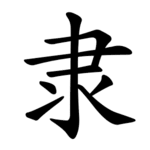Radical 171
Radical 171 meaning "slave" is 1 of 9 Kangxi radicals (214 radicals total) composed of 8 strokes.
| 隶 | ||
|---|---|---|
| ||
| 隶 (U+96B6) "slave" | ||
| Pinyin: | lì | |
| Bopomofo: | ㄌㄧˋ | |
| Wade–Giles: | li4 | |
| Cantonese Yale: | dai6 | |
| Jyutping: | dai6 | |
| Kana: | タイ tai, およぶ oyobu | |
| Kanji: | 隷旁 reizukuri | |
| Hangul: | 미칠 michil; 종 jong | |
| Sino-Korean: | 이 i, 대 dae, 례 rye, 예 ye | |
| Hán-Việt: | đãi, lệ | |
| Stroke order animation | ||
 | ||
In the Kangxi Dictionary there are 12 characters (out of 49,030) to be found under this radical.
Characters with Radical 171
| strokes | character |
|---|---|
| without additional strokes | 隶 |
| 8 additional strokes | 隷 |
| 9 additional strokes | 隸 |
Literature
- Fazzioli, Edoardo (1987). Chinese calligraphy : from pictograph to ideogram : the history of 214 essential Chinese/Japanese characters. calligraphy by Rebecca Hon Ko. New York: Abbeville Press. ISBN 0-89659-774-1.
- Lunde, Ken (Jan 5, 2009). "Appendix J: Japanese Character Sets" (PDF). CJKV Information Processing: Chinese, Japanese, Korean & Vietnamese Computing (Second ed.). Sebastopol, Calif.: O'Reilly Media. ISBN 978-0-596-51447-1.
gollark: M O N O M O R P H I S E ™
gollark: It's some kind of weird type switch.
gollark: C has "generics" but they are not what anyone actually means.
gollark: As the ancient mages once said, "lol no generics".
gollark: Yes, the compile times are awful!
This article is issued from Wikipedia. The text is licensed under Creative Commons - Attribution - Sharealike. Additional terms may apply for the media files.